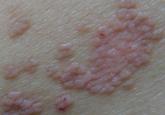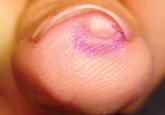Article

Multiple Tumors of the Follicular Infundibulum: A Cutaneous Reaction Pattern?
The etiology of tumor of the follicular infundibulum (TFI) is unknown. Eruptive forms of TFI are rare. We present the case of a 49-year-old woman...
Lindsey Hunter-Ellul, MD; Shalini Reddy, MD; Mara Dacso, MD; Samantha Robare-Stout, MD; Michael Wilkerson, MD
Drs. Hunter-Ellul, Dacso, Robare-Stout, and Wilkerson are from the Department of Dermatology, The University of Texas Medical Branch at Galveston. Dr. Reddy is from Boston University, School of Medicine, Massachusetts.
The authors report no conflict of interest.
Correspondence: Michael Wilkerson, MD, The University of Texas Medical Branch, Department of Dermatology, 301 University Blvd, 4.112 McCullough Bldg, Galveston, TX 77555-0783 (mgwilker@utmb.edu).

Keratoacanthomas are rapidly growing, typically painless, cutaneous neoplasms that often develop on sun-exposed areas. They can occur spontaneously or following trauma and have the propensity to regress with time. However, keratoacanthomas can be aggressive, becoming locally destructive; therefore, they are typically treated to avoid further morbidity.
To the Editor:
A 61-year-old man with a medical history of type 2 diabetes mellitus presented to us with a 2.5×3.0-cm erythematous, ulcerated, and exophytic tumor on the right dorsal forearm that had rapidly developed over 2 weeks. A tangential biopsy was performed followed by treatment with electrodesiccation and curettage (ED&C). Histology revealed a squamous cell carcinoma (SCC), keratoacanthoma (KA) type. Over the next 11 days the lesion rapidly recurred and the patient returned with his own daily photodocumentation of the KA’s progression (Figure). The lesion was re-excised with 5-mm margins; histology again revealed SCC, KA type, with deep margin involvement. Chest radiograph revealed findings suspicious for metastatic lesions in the right lung. He was referred to oncology for metastatic workup; positron emission tomography was negative and ultimately the lung lesion was found to be benign. The patient underwent adjuvant radia-tion to the KA resection bed and lymph nodes with minimal side effects. The patient has remained cancer free to date.
Keratoacanthomas are rapidly growing, typically painless, cutaneous neoplasms that often develop on sun-exposed areas. They can occur spontaneously or following trauma and have the propensity to regress with time.1-3 They are described as progressing through 3 clinical stages: rapid proliferation, mature/stable, and involution. However, KAs can be aggressive, becoming locally destructive; therefore, KAs are typically treated to avoid further morbidity. Keratoacanthomas may be considered a subtype of SCC, as some have the potential to become locally destructive and metastasize.3-5 There are reports of spontaneous resolution of KAs over weeks to months, though surgical excision is the gold standard of treatment.3,5
Reactive KA is a subtype that is thought to develop at the site of prior trauma, representing a sort of Köbner phenomenon.3,4 We demonstrated a case of a recurrent KA in the setting of recent ED&C. Several reports describe KAs developing after dermatologic surgery, including Mohs micrographic surgery, laser resurfacing, radiation therapy, and after skin grafting.3,4,6 Trauma-induced epidermal injury and dermal inflammation may play a role in postoperative KA formation or recurrence.6
Keratoacanthoma recurrence has been reported in 3% to 8% of cases within a few weeks after treatment, as seen in our current patient.3,5 In our case, the patient photodocumented the regrowth of his lesion (Figure). Treatment of reactive KAs may be therapeutically challenging, as they can form or worsen with repeated surgeries and may require several treatment modalities to eradicate them.4 Treatment options include observation, ED&C, excision, Mohs micrographic surgery, radiation, cryosurgery, laser, isotretinoin, acitretin, imiquimod, 5-fluorouracil, methotrexate, interferon alfa-2b, or bleomycin, to name a few.3,4,7
Combination therapy should be considered in the presence of recurrent and/or aggressive KAs, such as in our case. Our patient has remained disease free after a combination of surgical excision with radiation therapy.

The etiology of tumor of the follicular infundibulum (TFI) is unknown. Eruptive forms of TFI are rare. We present the case of a 49-year-old woman...

Superficial acral fibromyxoma (SAFM) is a rare fibromyxoid mesenchymal tumor with a predilection for the distal extremities and frequent nail bed...

There are anecdotal reports of dogs detecting melanoma and studies of canines being able to not only detect but also distinguish cancer from...
